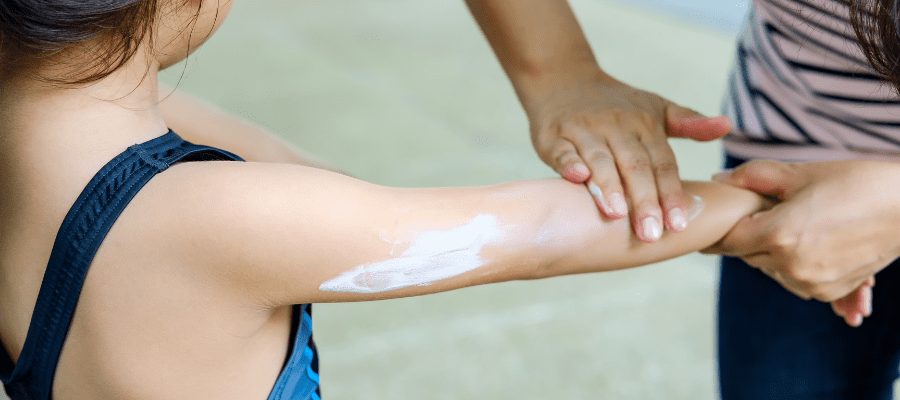With the temperatures rising, it’s important to make sure your kids are safe in the sun. Here are some tips from Dr. Carole Anderson for keeping sunscreen and water safe.
Sunscreen: Are The Chemicals in Sunscreen Dangerous? Is Higher SPF Better?
Claims that traditional sunscreen ingredients are toxic or hazardous to human health haven’t been proven. However, the FDA has acknowledged that more safety data is needed, especially for oxybenzone and avobenzone.
Mineral-based sunscreens are your best choice currently as they DO NOT get absorbed into your skin as traditional sunscreens do.
These products contain titanium dioxide and zinc oxide that stay on the skin’s surface, deflecting the sun’s harmful rays. Select products with BOTH of these ingredients – titanium alone does not filter out the UVA rays.
Mineral-based sunscreens leave a white film after application, and this is NORMAL. They are gentler on sensitive skin. They also are the preferred sunscreen for use in our oceans for that reason as well – they are less harmful to the environment.
Chose SPFs between 30 and 50. There is no need to go beyond SPF 50. Chose water-resistant when possible. Apply approximately 123 minutes prior to going outdoors.
Lotions are easier to apply and offer far better coverage than sunscreen spray. Apply frequently (every 2 hours at minimum, more frequently if in the water). IF you do use a spray, make sure you use your hand to evenly distribute the liquid after application.
Sun Protection For Infants
For infants less than six months of age, protective SPF clothing, hats, and sunglasses are the preferred method of protection. Sunscreen can be used on small areas of the body, such as the face, if protective clothing is not available. Remember that the sun’s rays can be reflective even in shaded areas and on cloudy days. Encourage plenty of water and monitor that they do not get overheated.
Water Safety For Kids
Number one rule- SUPERVISION! Kids can drown in as little as 2 inches of water, so even a toilet bowl or sink can be a hazard. Always watch children closely when they’re in or around water, regardless of their swimming ability. Assign an adult to each child or hand off that supervision to another adult before leaving an area. Don’t assume someone else is watching your child without verbal confirmation from that adult. Young kids or weak swimmers should have an adult swimmer within arm’s reach to provide “touch supervision.”
Swimming Lessons
Kids can start taking them at age one. Younger kids often begin with water survival skills training (rolling n their back, floating) and then, with time, learning how to swim. Smaller classes or private instruction often time works best for young kids. If you are an adult that doesn’t know how to swim or is a weak swimmer, get instruction as well.
Wear a Life Jacket
Make sure it is United States Coast Guard (USCG) approved and fits your child’s size and weight to adequately protect them. It should fit snuggly when fastened. With your child’s arms extended above their head, grasp the top of the arm openings and gently pull up on the fastened life vest. If the jacket rides up over the child’s chin or face, the jacket is too big for the child.
Just like a bike helmet, your child is more likely to wear and wear it properly if you, as an adult, are also modeling that safety feature. Make it a “non-negotiable” like riding in a car seat for your child, any time you are around water, that means, even when playing in the sand at the beach.
There are infant life jackets with head support with a loop and strap that go between the legs. They are designed to roll them onto their backs and support their heads out of the water. The loop is to lift your child out of the water and the leg strap to ensure they don’t slip out.
Summer is a great time for families to spend outdoors but practicing sun safety is important to keep your children safe and healthy. Be sure to sign up for our newsletter to stay up-to-date on health and safety tips!
About the Author
Carole Anderson, DO
Dr. Carole Anderson joined The Youth Clinic in 2001. She graduated from medical school at the Kirksville College of Osteopathic Medicine in Kirksville, Missouri. Dr. Anderson completed her pediatric residency as well as a fellowship in Neonatology at Michigan State University in Lansing, Michigan. Dr. Anderson is originally from Michigan. Dr. Anderson is Board Certified and a fellow of the American Academy of Pediatrics.


